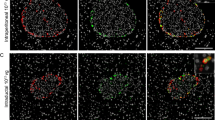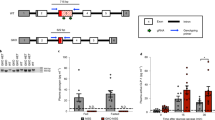Abstract
Glucagon-like peptide 1 (GLP-1) is a promising candidate for the treatment of type II diabetes. However, the short in vivo half-life of GLP-1 has made peptide-based treatments challenging. Gene therapy aimed at achieving continuous GLP-1 expression presents one way to circumvent the rapid turnover of GLP-1. We have created a GLP-1 minigene that can direct the secretion of active GLP-1 (amino acids 7–37). Plasmid and adenoviral expression vectors encoding the 31-amino-acid peptide linked to leader sequences required for secretion of GLP-1 yielded sustained levels of active GLP-1 that were significantly greater than endogenous levels. Systemic administration of expression vectors to animals using two diabetic rodent models, db/db mice and Zucker Diabetic Fatty (ZDF) rats, yielded elevated GLP-1 levels that lowered both the fasting and random-fed hyperglycemia present in these animals. Because the insulinotropic actions of GLP-1 are glucose dependent, no evidence of hypoglycemia was observed. Improved glucose homeostasis was demonstrated by improvements in %HbA1c (glycated hemoglobin) and in glucose tolerance tests. GLP-1-treated animals had higher circulating insulin levels and increased insulin immunostaining of pancreatic sections. GLP-1-treated ZDF rats showed diminished food intake and, in the first few weeks following vector administration, a diminished weight gain. These results demonstrate the feasibility of gene therapy for type II diabetes using GLP-1 expression vectors.
This is a preview of subscription content, access via your institution
Access options
Subscribe to this journal
Receive 12 print issues and online access
$259.00 per year
only $21.58 per issue
Buy this article
- Purchase on Springer Link
- Instant access to full article PDF
Prices may be subject to local taxes which are calculated during checkout





Similar content being viewed by others
References
Ferrannini E . Insulin resistance versus insulin deficiency in non-insulin-dependent diabetes mellitus: problems and prospects. Endocr Rev 1998; 19: 477–490.
Mojsov S, Heinrich G, Wilson IB, Ravazzola M, Orci L, Habener JF . Preproglucagon gene expression in pancreas and intestine diversifies at the level of post-translational processing. J Biol Chem 1986; 261: 11880–11889.
Elliott RM, Morgan LM, Tredger JA, Deacon S, Wright J, Marks V . Glucagon-like peptide-1 (7–36) amide and glucose-dependent insulinotropic polypeptide secretion in response to nutrient ingestion in man: acute post-prandial and 24-h secretion patterns. J Endocrinol 1993; 138: 159–166.
Drucker DJ, Philippe J, Mojsov S, Chick WL, Habener JF . Glucagon-like peptide I stimulates insulin gene expression and increases cyclic AMP levels in a rat islet cell line. Proc Natl Acad Sci USA 1987; 84: 3434–3438.
Fehmann HC, Habener JF . Insulinotropic hormone glucagon-like peptide-I (7–37) stimulation of proinsulin gene expression and proinsulin biosynthesis in insulinoma beta TC-1 cells. Endocrinology 1992; 130: 159–166.
Holz GG, Kuhtreiber WM, Habener JF . Pancreatic beta-cells are rendered glucose-competent by the insulinotropic hormone glucagon-like peptide-1 (7–37). Nature 1993; 361: 362–365.
Xu G, Stoffers DA, Habener JF, Bonner-Weir S . Exendin-4 stimulates both beta-cell replication and neogenesis, resulting in increased beta-cell mass and improved glucose tolerance in diabetic rats. Diabetes 1999; 48: 2270–2276.
Stoffers DA, Kieffer TJ, Hussain MA, Drucker DJ, Bonner-Weir S, Habener JF et al. Insulinotropic glucagon-like peptide 1 agonists stimulate expression of homeodomain protein IDX-1 and increase islet size in mouse pancreas. Diabetes 2000; 49: 741–748.
Wettergren A, Schjoldager B, Mortensen PE, Myhre J, Christiansen J, Holst JJ . Truncated GLP-1 (proglucagon 78–107-amide) inhibits gastric and pancreatic functions in man. Dig Dis Sci 1993; 38: 665–673.
Willms B, Werner J, Holst JJ, Orskov C, Creutzfeldt W, Nauck MA . Gastric emptying, glucose responses, and insulin secretion after a liquid test meal: effects of exogenous glucagon-like peptide-1 (GLP-1)-(7–36) amide in type 2 (noninsulin-dependent) diabetic patients. J Clin Endocrinol Metab 1996; 81: 327–332.
Toft-Nielsen MB, Madsbad S, Holst JJ . Continuous subcutaneous infusion of glucagon-like peptide 1 lowers plasma glucose and reduces appetite in type 2 diabetic patients. Diabetes Care 1999; 22: 1137–1143.
Flint A, Raben A, Astrup A, Holst JJ . Glucagon-like peptide 1 promotes satiety and suppresses energy intake in humans. J Clin Invest 1998; 101: 515–520.
Turton MD, O'Shea D, Gunn I, Beak SA, Edwards CM, Meeran K et al. A role for glucagon-like peptide-1 in the central regulation of feeding. Nature 1996; 379: 69–72.
van Dijk G, Thiele TE, Seeley RJ, Woods SC, Bernstein IL . Glucagon-like peptide-1 and satiety. Nature 1997; 385: 214.
Creutzfeldt WO, Kleine N, Willms B, Orskov C, Holst JJ, Nauck MA . Glucagonostatic actions and reduction of fasting hyperglycemia by exogenous glucagon-like peptide I (7–36) amide in type I diabetic patients. Diabetes Care 1996; 19: 580–586.
Komatsu R, Matsuyama T, Namba M, Watanabe N, Itoh H, Kono N et al. Glucagonostatic and insulinotropic action of glucagonlike peptide I-(7–36)-amide. Diabetes 1989; 38: 902–905.
Kawai K, Suzuki S, Ohashi S, Mukai H, Ohmori H, Murayama Y et al. Comparison of the effects of glucagon-like peptide-1-(1–37) and -(7–37) and glucagon on islet hormone release from isolated perfused canine and rat pancreases. Endocrinology 1989; 124: 1768–1773.
Nauck MA, Heimesaat MM, Behle K, Holst JJ, Nauck MS, Ritzel R et al. Effects of glucagon-like peptide 1 on counterregulatory hormone responses, cognitive functions, and insulin secretion during hyperinsulinemic, stepped hypoglycemic clamp experiments in healthy volunteers. J Clin Endocrinol Metab 2002; 87: 1239–1246.
Villanueva-Penacarrillo ML, Alcantara AI, Clemente F, Delgado E, Valverde I . Potent glycogenic effect of GLP-1 (7–36) amide in rat skeletal muscle. Diabetologia 1994; 37: 1163–1166.
Lopez-Delgado MI, Morales M, Villanueva-Penacarrillo ML, Malaisse WJ, Valverde I . Effects of glucagon-like peptide 1 on the kinetics of glycogen synthase a in hepatocytes from normal and diabetic rats. Endocrinology 1998; 139: 2811–2817.
Deacon CF . Therapeutic strategies based on glucagon-like peptide 1. Diabetes 2004; 53: 2181–2189.
Mentlein R, Gallwitz B, Schmidt WE . Dipeptidyl-peptidase IV hydrolyses gastric inhibitory polypeptide, glucagon-like peptide-1 (7–36) amide, peptide histidine methionine and is responsible for their degradation in human serum. Eur J Biochem 1993; 214: 829–835.
Hupe-Sodmann K, McGregor GP, Bridenbaugh R, Goke R, Goke B, Thole H et al. Characterisation of the processing by human neutral endopeptidase 24.11 of GLP-1 (7–36) amide and comparison of the substrate specificity of the enzyme for other glucagon-like peptides. Regul Pept 1995; 58: 149–156.
Edwards CM, Stanley SA, Davis R, Brynes AE, Frost GS, Seal LJ et al. Exendin-4 reduces fasting and postprandial glucose and decreases energy intake in healthy volunteers. Am J Physiol Endocrinol Metab 2001; 281: E155–E161.
Kim JG, Baggio LL, Bridon DP, Castaigne JP, Robitaille MF, Jette L et al. Development and characterization of a glucagon-like peptide 1-albumin conjugate: the ability to activate the glucagon-like peptide 1 receptor in vivo. Diabetes 2003; 52: 751–759.
Agerso H, Jensen LB, Elbrond B, Rolan P, Zdravkovic M . The pharmacokinetics, pharmacodynamics, safety and tolerability of NN2211, a new long-acting GLP-1 derivative, in healthy men. Diabetologia 2002; 45: 195–202.
Baggio LL, Huang Q, Brown TJ, Drucker DJ . A recombinant human glucagon-like peptide (GLP)-1-albumin protein (albugon) mimics peptidergic activation of GLP-1 receptor-dependent pathways coupled with satiety, gastrointestinal motility, and glucose homeostasis. Diabetes 2004; 53: 2492–2500.
Choi S, Oh S, Lee M, Kim SW . Glucagon-like peptide-1 plasmid construction and delivery for the treatment of type 2 diabetes. Mol Ther 2005; 12: 885–891.
Oh S, Lee M, Ko KS, Choi S, Kim SW . GLP-1 gene delivery for the treatment of type 2 diabetes. Mol Ther 2003; 7: 478–483.
Rouille Y, Westermark G, Martin SK, Steiner DF . Proglucagon is processed to glucagon by prohormone convertase PC2 in alpha TC1–6 cells. Proc Natl Acad Sci USA 1994; 91: 3242–3246.
Burcelin R, Dolci W, Thorens B . Long-lasting antidiabetic effect of a dipeptidyl peptidase IV-resistant analog of glucagon-like peptide-1. Metabolism 1999; 48: 252–258.
Yew NS, Przybylska M, Ziegler RJ, Liu D, Cheng SH . High and sustained transgene expression in vivo from plasmid vectors containing a hybrid ubiquitin promoter. Mol Ther 2001; 4: 75–82.
Scaria A, St George JA, Jiang C, Kaplan JM, Wadsworth SC, Gregory RJ . Adenovirus-mediated persistent cystic fibrosis transmembrane conductance regulator expression in mouse airway epithelium. J Virol 1998; 72: 7302–7309.
Armentano D, Sookdeo CC, Hehir KM, Gregory RJ, St George JA, Prince GA et al. Characterization of an adenovirus gene transfer vector containing an E4 deletion. Hum Gene Ther 1995; 6: 1343–1353.
Peterson R . The Zucker Diabetic Fatty (ZDF) Rat. Smith-Gordon: London, 1995.
Farilla L, Hui H, Bertolotto C, Kang E, Bulotta A, Di Mario U et al. Glucagon-like peptide-1 promotes islet cell growth and inhibits apoptosis in Zucker diabetic rats. Endocrinology 2002; 143: 4397–4408.
Unger RH, Grundy S . Hyperglycaemia as an inducer as well as a consequence of impaired islet cell function and insulin resistance: implications for the management of diabetes. Diabetologia 1985; 28: 119–121.
Nauck MA, Niedereichholz U, Ettler R, Holst JJ, Orskov C, Ritzel R et al. Glucagon-like peptide 1 inhibition of gastric emptying outweighs its insulinotropic effects in healthy humans. Am J Physiol 1997; 273: E981–E988.
Valverde I, Villanueva-Penacarrillo ML, Malaisse WJ . Pancreatic and extrapancreatic effects of GLP-1. Diabetes Metab 2002; 28: 3S85–3S89; discussion 83S108–83S112.
Hansotia T, Baggio LL, Delmeire D, Hinke SA, Yamada Y, Tsukiyama K et al. Double incretin receptor knockout (DIRKO) mice reveal an essential role for the enteroinsular axis in transducing the glucoregulatory actions of DPP-IV inhibitors. Diabetes 2004; 53: 1326–1335.
Yki-Jarvinen H . Glucose toxicity. Endocr Rev 1992; 13: 415–431.
Young AA, Gedulin BR, Bhavsar S, Bodkin N, Jodka C, Hansen B et al. Glucose-lowering and insulin-sensitizing actions of exendin-4: studies in obese diabetic (ob/ob, db/db) mice, diabetic fatty Zucker rats, and diabetic rhesus monkeys (Macaca mulatta). Diabetes 1999; 48: 1026–1034.
Gedulin BR, Nikoulina SE, Smith PA, Gedulin G, Nielsen LL, Baron AD et al. Exenatide (exendin-4) improves insulin sensitivity and {beta}-cell mass in insulin-resistant obese fa/fa Zucker rats independent of glycemia and body weight. Endocrinology 2005; 146: 2069–2076.
Johnson JH, Ogawa A, Chen L, Orci L, Newgard CB, Alam T et al. Underexpression of beta cell high Km glucose transporters in noninsulin-dependent diabetes. Science 1990; 250: 546–549.
Hummel KP, Coleman DL, Lane PW . The influence of genetic background on expression of mutations at the diabetes locus in the mouse. I. C57BL-KsJ and C57BL-6J strains. Biochem Genet 1972; 7: 1–13.
Larsen PJ, Fledelius C, Knudsen LB, Tang-Christensen M . Systemic administration of the long-acting GLP-1 derivative NN2211 induces lasting and reversible weight loss in both normal and obese rats. Diabetes 2001; 50: 2530–2539.
Dakin CL, Small CJ, Batterham RL, Neary NM, Cohen MA, Patterson M et al. Peripheral oxyntomodulin reduces food intake and body weight gain in rats. Endocrinology 2004; 145: 2687–2695.
Quddusi S, Vahl TP, Hanson K, Prigeon RL, D'Alessio DA . Differential effects of acute and extended infusions of glucagon-like peptide-1 on first- and second-phase insulin secretion in diabetic and nondiabetic humans. Diabetes Care 2003; 26: 791–798.
Souza DW, Armentano D . Novel cloning method for recombinant adenovirus construction in Escherichia coli. Biotechniques 1999; 26: 502–508.
Hodges BL, Taylor KM, Joseph MF, Bourgeois SA, Scheule RK . Long-term transgene expression from plasmid DNA gene therapy vectors is negatively affected by CpG dinucleotides. Mol Ther 2004; 10: 269–278.
Acknowledgements
We are grateful to W Weber for help with insulin immunohistochemistry quantitation, to A Sullivan, M Joseph, and S Boulé for expert technical assistance, and to C Arbeeny for helpful suggestions.
Author information
Authors and Affiliations
Corresponding author
Rights and permissions
About this article
Cite this article
Parsons, G., Souza, D., Wu, H. et al. Ectopic expression of glucagon-like peptide 1 for gene therapy of type II diabetes. Gene Ther 14, 38–48 (2007). https://doi.org/10.1038/sj.gt.3302842
Received:
Revised:
Accepted:
Published:
Issue Date:
DOI: https://doi.org/10.1038/sj.gt.3302842
Keywords
This article is cited by
-
Therapeutic gene delivery using bioreducible polymers
Archives of Pharmacal Research (2014)
-
Long-term, antidiabetogenic effects of GLP-1 gene therapy using a double-stranded, adeno-associated viral vector
Gene Therapy (2011)
-
Effective and safe gene-based delivery of GLP-1 using chitosan/plasmid-DNA therapeutic nanocomplexes in an animal model of type 2 diabetes
Gene Therapy (2011)
-
DsAAV8-mediated expression of glucagon-like peptide-1 in pancreatic beta-cells ameliorates streptozotocin-induced diabetes
Gene Therapy (2010)
-
Gene Therapy for Diabetes: Metabolic Effects of Helper-dependent Adenoviral Exendin 4 Expression in a Diet-induced Obesity Mouse Model
Molecular Therapy (2008)



